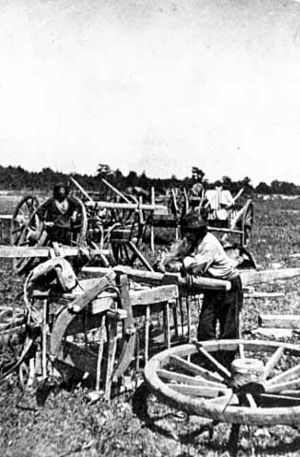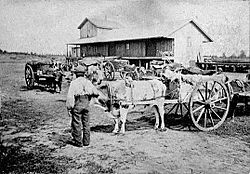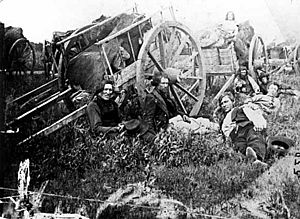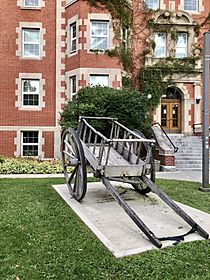Red River cart facts for kids
The Red River cart was a special two-wheeled cart. It was made completely from wood and animal parts, with no metal at all! These carts were often pulled by oxen, but sometimes by horses or mules.
People used these carts a lot in the 1800s. They were important for the fur trade and for people moving west in Canada and the United States. You would find them around the Red River area and on the plains. The Métis people created these simple carts. They used them in their homes along the Red River, in what is now Manitoba. The carts helped the Métis hunt bison (buffalo) without needing to travel only by river. This made the buffalo hunt a bigger business.
Contents
What is a Red River Cart?
The first Red River carts appeared around 1801. This was at Fort Pembina, near today's Canada–United States border. These carts might have come from French Canadian carts or Scottish carts. But they were changed to use only materials found nearby.
How Red River Carts Were Built
In the early West, nails were hard to find or very costly. So, these carts had no iron or metal parts. They were built entirely from wood and animal hide. This made them easy to fix with local materials.
A cart could even be taken apart. Its wheels could be covered with bison hides to make them float. Then the cart's body could be placed on top. This way, the cart could float across rivers and streams! Red River carts were very strong. They could carry heavy loads, up to about 450 kilograms (1,000 pounds).
The cart had two long oak poles, about 3.6 meters (12 feet) long. These poles, called "trams," went around the animal pulling the cart. They also formed the cart's main frame. Wooden cross-pieces held the floorboards. Front, side, and back boards, made of willow or cut wood, formed the cart's box. These wooden parts were joined using special wood joints.
The axle was also made of strong oak wood. It was tied to the cart with wet strips of bison hide, called "shaganappi." As the hide dried, it would shrink and hold the axle very tightly. The axle connected two large spoked wheels. These wheels were about 1.5 to 1.8 meters (5 or 6 feet) wide. They were built with a slight outward curve from the center. This "dished" shape gave them extra stability.
Why Oxen Pulled the Carts
At first, small horses from the First Nations pulled the carts. But after the 1820s, oxen became the main choice. Oxen were stronger and could work longer. Their hooves also spread their weight better in wet, swampy areas.
Because the carts were made from local materials, they were easy to repair. People would carry extra shaganappi and wood. A cart might break several axles on a long trip! The axles were never greased. Grease would pick up dust, which would act like sandpaper and stop the cart. This meant the carts made a very loud, squealing sound. People called it the "North West fiddle." One person said the sound was worse than "a den of wild beasts."
How Red River Carts Were Used
The Red River carts traveled on special paths called the Red River Trails. These trails went from the Red River Colony to fur trading posts like Pembina and St. Joseph. They ended in places like Mendota and St. Paul, Minnesota. On the way to St. Paul, the carts usually carried furs. On the return trip, they brought back trade goods and supplies for the colony.
The Carlton Trail was another important route for these carts. It went west from the Red River Colony to Fort Carlton and Fort Edmonton. These forts are in today's Saskatchewan and Alberta. There were also branches, like the Fort à la Corne Trail. Red River carts were the main way to travel in the Canadian West. They were used from early settlement until the Canadian Pacific Railway arrived later in the century. Carts could not go west of Fort Edmonton. There were no roads or trails for wheeled vehicles over the Rocky Mountains.
The Hudson's Bay Company started using Red River carts as their main commercial carts in the 1860s. This happened because the Minnesota cart route became more successful than the boat route from York Factory.
The Métis and Anglo-Metis peoples invented and developed the Red River cart. It became a symbol of their history. It showed their way of life, which was based on moving around and strong community ties.
Where to See Red River Carts Today
You can see a real Red River cart from the 1850s at the National Museum of American History. It is part of their American Enterprise exhibit.
You can also find models of these carts in places like St. Louis, Selkirk, Manitoba, Duck Lake, and Prince Albert, Saskatchewan. The Clay County, Minnesota, Historical Society has a full-size copy. So does the Fort Vancouver National Historic Site in Washington. The Fort Nisqually Living History Museum in Washington has a half-size copy.
Fort Snelling, a historic site near Saint Paul, Minnesota, has a full-size copy too. This fort was an important stop on the Red River Trails.
The Remington Carriage Museum in Cardston, Alberta, also has a full-size copy. You can find another one at Bent's Old Fort National Historic Site in La Junta, Colorado.
The Faculty of Native Studies at the University of Alberta has a full-size Red River Cart outside Pembina Hall. The Métis Nation of Alberta gave this cart to the Faculty in 2015. The Métis also gave a cart to the Juno Beach Centre in France. This was to remember their part in the 1944 invasion of Normandy and the liberation of Europe.






